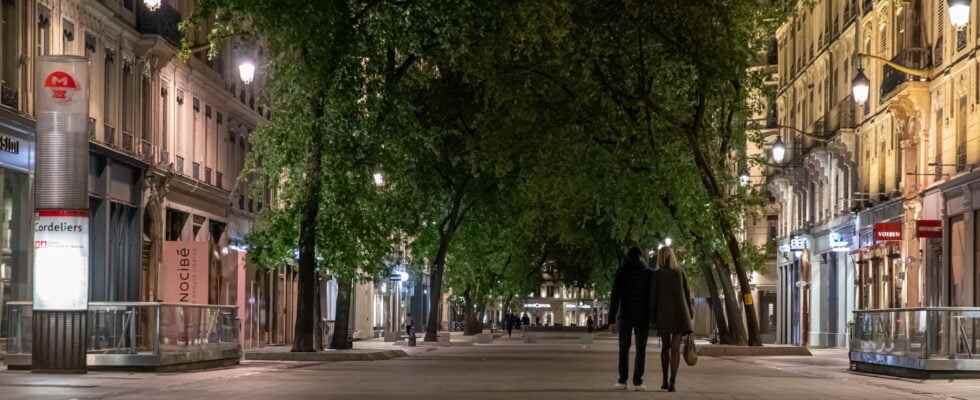CURFEW. While it was ruled out at the end of 2021, the curfew could be put back on the table during a Health Defense Council organized on Wednesday January 5, 2022. Emmanuel Macron and his closest entourage must take stock of the situation. Covid-19 epidemic in France. From there to reinstate the measure?
[Mis à jour le 3 janvier 2022, à 13 heures] Could curfew make a comeback in 2022? Just like the confinement, much more radical, the measure is feared in the face of the outbreak of Covid-19 known since the end of 2021, with an explosion in the number of positive cases and an increase in admissions to hospitals. While the hypothesis of placing under a bell has been ruled out, that of an obligation to be at home at a specific time does not also seem to be favored by the executive. During the press conference given on December 27 at the end of the last Sanitary Defense Council, Jean Castex did not mention the establishment of such a device, bringing into force a whole other series of measures around wearing a mask or restricting consumption.
Could the option now be more seriously considered, when the head of government brings together several ministers on Monday January 3, 2022 and will participate in a new Health Defense Council on Wednesday January 5? The executive seems reluctant to activate this lever, preferring to focus on vaccination with the reduction of the time to receive the booster dose, increase the pressure on unvaccinated people or even hammer out his message around barrier gestures.
However, on the island of Reunion, the inhabitants must compose since January 1 with a curfew, imposed by the prefect. The state representative spoke of “hospital tension and pressure on the medical and resuscitation services” and said he wanted to “act to curb the exponential circulation of the virus”. On the Indian Ocean side, the incidence rate is however lower than in mainland France (1,049 cases per 100,000 inhabitants, against 1,492), but the figures indicate a proportion of patients in intensive care on the island almost as high. than in France (4 per 100,000 against 5 per 100,000). However, the share of the island population to be fully vaccinated is only 62.8%, compared to 81.13% nationally.
In line with its strategy to limit vaccination as much as possible, the government should not impose restrictions on a population that is largely vaccinated. All the more so since the introduction of the vaccine pass has been under study in the National Assembly since January 3 and that it will allow, according to Yaël Braun-Pivet, LREM deputy and president of the law committee, “to avoid much more coercive measures “, such as confinements or curfews. Without being certain of the effectiveness of such a device: “if that does not work, much more coercive measures will have to be considered”.
The hypothesis of an implementation of exit restrictions from a certain time therefore remains possible in January and the Sanitary Defense Council of January 5 should make it possible to settle the subject. In France, a territorialized and then national curfew was introduced between October 2020 and June 2021. Its implementation was based on three criteria: an incidence rate greater than 250, an incidence rate in people over 65 years greater than 100 and an occupancy rate of resuscitation beds by Covid patients greater than 30%. Thresholds already crossed for several days in this 5th or 6th wave. According to data from Public Health France dated December 30, the national incidence rate exceeds 1,500 cases per 100,000 inhabitants, that among people over 65 years of about -00 and the number of intensive care beds occupied by patients affected by a severe form of the virus by 69%. Objectively, all the signals (compared to the criteria established by the authorities) are in the red.
But since then, the government has not only looked at these data to decide and has changed its tune over the months of the epidemic, with in particular the opening of vaccination. And for a simple reason: even if the virus spreads more, it statistically causes fewer victims and serious forms, hospitals are more protected in proportion to cases of contamination. No more restrictions for everyone, the goal is to impose more constraints on the unvaccinated (10% of over 18 years). “Each week, with the level of knowledge that we have, we consider that this is important, in this case the vaccination, that can be discussed, but we do not choose it today”, had insisted on specify Olivier Véran at the end of December, leaving doubt about a possible new establishment.
The curfew, like confinement, is apparently one of the government’s latest weapons to stem a possible saturation of hospitals. Previously, the question of establishing new restrictions in places of assembly is still possible. After the gauges inside and outside, after wearing the extended mask, after the ban on alcohol consumption while standing or with zinc in bars and cafes, after the ban on eating in public places such as theaters, cinemas and sports facilities, it is indeed the closure of these places and businesses that can still be activated. While nightclubs are closed until the end of January, at least it is restaurants, bars, shops, places of culture and sport that seem in the hot seat.
Before curfew or confinement restrictions, the executive will probably intend to activate the levers that work to break an epidemic dynamic: limit the opportunities for mixing the population in closed places where the mask is only little or not worn, as in restaurants and bars.
